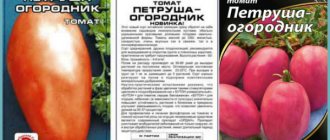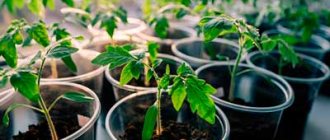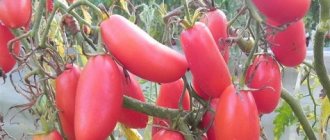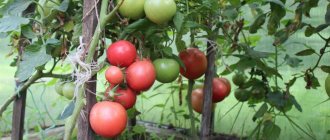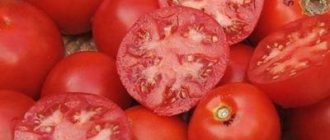If you are already experienced in growing tomatoes, and you want variety, for example, more fancy shapes and colors of your favorite vegetable, then the Truffle tomato variety is exactly what you need. Here you have an unusual shape and three options for the color of the fruit, which will look fantastically beautiful in a canned jar. The agricultural technology of this variety is not much different from the cultivation of other tomatoes; the Truffle tomato is more suitable for growing in a greenhouse, but in the south of the country it will feel good in open ground.
Next, we will talk in more detail about the Red Truffle tomato variety, which differs from the other two varieties only in its more familiar color, but in terms of taste they are all equally wonderful. I hope that the information will be useful and interesting, and you will try to grow multi-colored “truffles” in your summer cottage.
Description and characteristics of the variety
The Truffle tomato variety was bred by Russian breeders for cultivation in open ground and greenhouses. It was registered in 2002 and since then has been in great demand among Russian gardeners.
- Determinate variety, standard. The bushes grow no more than 70 cm in height.
- It has a medium-early ripening period, producing the first ripe fruits 100-110 days after seed germination.
- Designed for cultivation in greenhouses and open ground.
- The root system is well developed, which supplies adequate nutrition to the entire plant and fruits. The roots grow quite large, so it is recommended to plant no more than 2-3 bushes per 1 square meter. m.
- It is recommended to form Truffle tomato bushes into 2-3 stems. Thanks to this, after the growth of the main stem stops, another shoot begins to bear fruit.
- The first flower cluster is formed above the 6-7 leaf. Each cluster bears 3-6 fruits. The first inflorescence develops very slowly; the plant spends a lot of effort on its formation. However, after the first fruits ripen, the ovaries form more actively and the tomatoes ripen faster. Some farmers specifically remove the first peduncle to save time.
- Good yield. With proper agricultural technology, 1 bush produces 6-8 kg of ripe vegetables. When planting 2 bushes per square meter, you can harvest up to 12-16 kg from this area.
- The variety is resistant to temperature changes and low temperatures, thanks to which this variety can be cultivated in the central and northern regions of Russia.
- Has good immunity to nightshade diseases. However, it can be affected by Phomasis. It is necessary to combat this disease by removing damaged fruits. And the bush itself is treated with the preparation “Hom”, watering and application of nitrogen fertilizers are reduced, and the greenhouse is ventilated more often. The course can also be affected by dry spotting, which is combated with the drugs “Antrakol”, “Consento” and “Tattu”. When growing Truffle tomatoes in open ground, especially in the southern regions, the bushes can be affected by rusty mites, which can be gotten rid of with the help of the preparation "Bison". In the greenhouse, tomatoes are attacked by melon aphids and thrips, against which the drug “Zubr” is also used.
Varieties of Truffle: black, yellow, red
Since the Truffle tomato is often called the Japanese truffle, one might think about its foreign origin. There is also such a point of view, but it is difficult to find out for certain about the origin of the variety, since it is not registered in the State Register of the Russian Federation, and seed producers call it a variety of domestic selection. The Truffle tomato is intended mainly for greenhouses, and only in the southern half of our country is it grown in unprotected soil.
The variety is a mid-early variety; it takes approximately 3.5–4 months from the emergence of seedlings to the ripening of the first tomatoes. The bushes are tall, about 150 cm, the plant is indeterminate. It is recommended to form bushes that usually have two stems. Since the root system is well developed, mistakes in watering are not fatal: the roots will find moisture for some time on their own.
The shape of the fruit is unique, due to which the variety got its name. It resembles the well-known but rare truffle mushroom. The fruits have significant ribbing and are not very large in size. The bulk of tomatoes weigh from 120 to 150 g, only a few grow up to 200 g. Most often, black, yellow and red varieties are grown, but there are several more. The skin of the fruit is thin, delicate, but durable, and has a strong shine. The pulp is fleshy, dense, has 4 or 5 seed nests. The main purpose of tomatoes is salad, that is, fresh consumption. However, the size and shape allow for whole-fruit canning. You can also spend excess harvest on sauces.
The usual yield of the variety is about 2–3 kg of tomatoes per bush. With intensive agricultural technology, the figure can be increased to 4 kg or 12–15 kg per 1 m2. Each cluster produces 5 or 6 fruits. All varieties of the variety are equally resistant to tomato diseases; extremely rarely they can catch late blight, blight or other attacks. The harvest tolerates transportation well, is stored fresh for up to three weeks, and the taste only improves.
Bushes of all varieties have weak stems, so fruit clusters also have to be tied up
Red truffle has fruits that are not quite red in color: they have a brownish tint. The tomatoes are sweet, almost without sourness. Their size is slightly smaller than other varieties; it is the red Truffle that is most often preserved in standard jars. The juice content is low, so it is less suitable than others for pastes or sauces, and even more so for preparing tomato juice. However, with smaller fruits, the overall yield of the red variety is the highest among its relatives.
Fruit characteristics
- Ripe fruits of the Red Truffle variety have a bright red color.
- Unripe fruits have a greenish spot near the stalk.
- The size of vegetables is average, most often they weigh 120-150 g, but they can gain weight up to 200 g.
- They have an unusual pear-shaped shape.
- The skin is tender and thin, easily removed if necessary.
- The concentration of dry substances is 6%.
- There are 5-6 seed chambers inside.
- Tomatoes have good keeping quality.
- They can ripen outside the bush, picked a little green. To do this, they are placed in wooden boxes and sent to a cool place. Under such conditions, tomatoes can be stored for up to 90 days.
- They have excellent taste.
Diseases and pests
| Late blight Control measures:
| |
| Black spot Control measures:
| |
| Gnawing owl Control measures:
|
Photo
Below are photos of the Red Truffle tomato variety.
Bush care
The bush of the review variety of tomatoes is usually formed into 2 stems.
Basic measures for caring for “Red Truffle” bushes:
- Regular watering after sunset with warm and settled water;
- Loosening the soil in an area planted with tomatoes;
- Weeding;
- Feeding with nutritious mineral complexes and organic fertilizers. To activate growth, the bushes are fed with preparations that contain nitrogen.
Asparagus: what is asparagus, types of asparagus, cultivation and care
Advantages and disadvantages
Among the positive qualities of these tomatoes are the following:
- Good immunity to nightshade diseases and harmful insects.
- Excellent taste.
- Good keeping quality.
- Resistance to transportation.
- Good yield.
Among the disadvantages are the following:
- Demanding about the watering regime.
- The stems must be tied to a support or trellis.
- Fertilizers must be applied regularly.
Reviews from gardeners
Rodebielesumer
We tried it the first year and liked everything. The yield is small, up to 1.5 kg per bush, but the taste is excellent, there is more sweetness than sourness, even after ripening the fruits remain dense and tasty.
Source: www.tomat-pomidor.com
Uncle
The taste of Japanese truffle is stable regardless of the season. He doesn't get bored.
Source: forum.prihoz.ru
Features of cultivation
The gardener must independently determine the time for sowing seeds for seedlings, depending on the region and cultivation conditions. The Red Truffle tomato variety is grown, like most varieties, by seedlings. Since the variety is an early ripening variety, it is better to sow the seeds for seedlings on March 15-20 for unheated greenhouses and April 1-10 for open ground.
The seeds are buried 1-1.5 cm into the soil and sprinkled with a small layer of soil. For the soil mixture, it is better to take 2 parts of turf soil, 2 parts of old humus and 1 part of sifted sand. After planting, the containers are covered with film or glass and sent to a room with a temperature of + 20-24 ° C until germination. After this, the film is removed and the containers are placed in a well-lit place. Picking is carried out when the seedlings have formed 1-2 true leaves. This procedure will help accelerate the development of the root system. 10-14 days after picking, the seedlings need to be fed.
7 days before transplanting plants, they are fertilized with potassium and phosphorus. Don't forget about moderate watering.
10 days before transferring the seedlings to a permanent place, they must begin to be hardened off. The seedlings are taken outside,
Transplantation of seedlings is carried out 50-55 days after emergence. By this time, a flower cluster may already appear on each seedling and buds may form.
Important! Transplantation must be done before the flowers bloom. Otherwise, this will lead to the ovaries falling off.
The seedlings are transferred to heated greenhouses in April, and to unheated greenhouses in mid-May. But it is necessary to plant seedlings in open ground when the average air temperature warms up to 15 degrees and the risk of night frosts has passed.
More information about growing tomatoes is described in the article: Technology of growing tomatoes. Secrets of planting and care
You might be interested in: How to properly plant tomatoes in a greenhouse: bush formation diagram, care features, photos and videos
Useful information: How to properly tie tomatoes in open ground: the best methods, step-by-step photo and video instructions
How to grow tomatoes
Seedlings are planted in the ground at the age of 55-65 days. By this time, 5-7 leaves are opening on the plant.
Landing
The plants are not watered 2-3 days before planting. This will make it easier to remove them from the container without damaging the roots.
On the eve of planting, the soil is thoroughly watered with a strong solution of potassium permanganate for disinfection.
Humus, wood ash or vermicompost are added to the planting hole or furrow. Spill 1-2 liters of water. Place the plant in damp soil, cover it with soil and compact it properly. Up to three plants are placed on one square meter.
The plant is not watered for a week after planting, because... The moisture introduced at the time of planting will be sufficient.
Plant care
Let's take a closer look at the process of caring for plants.
Watering
Tomato is a heat-loving plant; it does not like drafts and hypothermia. It is preferable to maintain dry air in the greenhouse. It is better to water the plants from a watering can with the sprayer removed once a week. During extreme heat and drought, watering is increased.
After the water is absorbed, it is useful to loosen the top layer of soil. This will prevent the formation of a hard crust on the surface of the earth, which injures the delicate stems of plants.
Weeding and loosening
Removing weeds loosens the soil and improves the penetration of oxygen to the roots of the plant.
Stepping and bush formation
Since the variety is indeterminate, the plant stem requires obligatory pinching. The bush grows in 2 stems. To do this, leave the lower stepson, and the rest are broken out.
Advice . It is better to break out the stepsons “on a stump”, leaving 2-3 cm. This will restrain the leaf axil from growing a new stepson in this place.
To avoid breaking and injury to branches, long stems of the plant require obligatory gartering to a support.
Plant nutrition
The main elements needed by the plant for abundant fruiting are nitrogen, potassium, phosphorus and calcium. At different growth stages, the plant requires different ratios of nutrients in fertilizers. For 10 liters of water dissolve in grams:
| Growth phase | Ammonium nitrate | Superphosphate | Potassium chloride |
| 1-2 weeks after landing | 15-20 | 45-50 | 5-10 |
| Before the formation of 3 fruit clusters | 25-30 | 70-80 | 20-25 |
| Until the end of the growing season | 30-40 | 30-40 | 25-30 |
It is important to observe the plant. If foliage growth occurs too intensively and flowers do not form, then the amount of nitrogen (ammonium nitrate) is reduced, and the dosage of potassium and phosphorus (superphosphate) is increased.
Features of cultivation and possible difficulties
The variety is unpretentious and will not cause much trouble in care. Avoid gross mistakes in agricultural technology, and the plant will reward you with a good harvest.
Among the most common errors in care are the following:
- excessive density of plantings;
- waterlogging;
- untimely loosening and weeding;
- increased air humidity in the greenhouse (more than 60%);
- lack of fertilizers and fertilizers.
Diseases and pests
The Red Truffle variety is resistant to nightshade diseases. But if you do encounter problems, these tips will help you overcome them:
- to treat bacterial infections, fungicides of chemical or biological origin are used (bio: Ecosil, Fitosporin; chemical: Ridomil, Bordeaux mixture);
- Spraying with tinctures of garlic, chamomile or celandine will help repel harmful insects;
- Aphids can be easily washed off with a warm soap solution.

